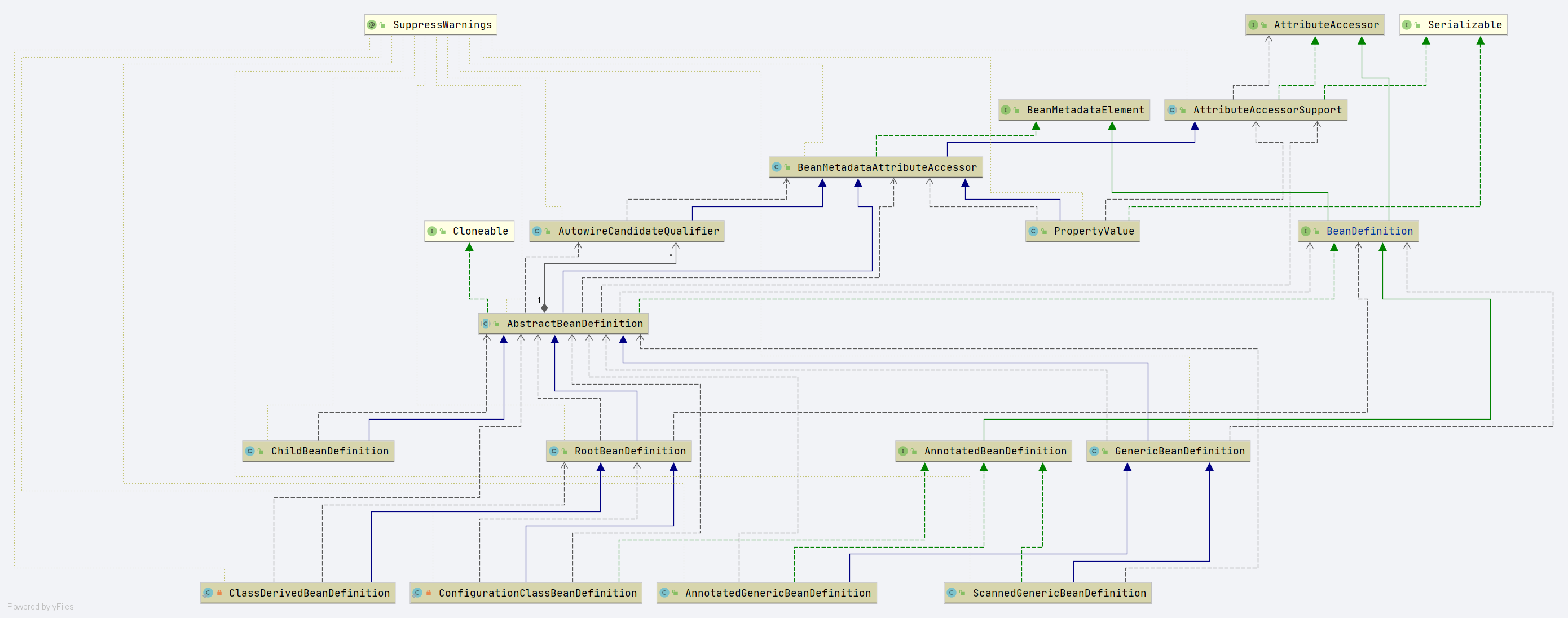Spring-Property
Spring Property
-
Author: HuiFer
-
源码阅读仓库: SourceHot-spring
-
相关类
org.springframework.beans.PropertyValuesorg.springframework.beans.PropertyValueorg.springframework.beans.MutablePropertyValues
-
类图如下

-
在 Spring IoC 中,非 Web 工程,使用 xml 或者注解进行配置主要使用到的是
PropertyValues,PropertyValue,MutablePropertyValues三个其中
PropertyValues是继承迭代器,具体实现在MutablePropertyValues他们处理的对象是PropertyValues关系就是这样.
-
开始类的解析了
PropertyValue
-
org.springframework.beans.PropertyValue -
类图

-
这个类暂时只关注两个属性
- name: 属性名称
- value: 属性值
对应标签
<property name="age" value="30"/>属性值一一对应填入.
MutablePropertyValues
-
org.springframework.beans.MutablePropertyValues -
属性
propertyValueList:属性列表, key:参数名称,value:具体数据processedProperties: 已经处理的属性名称converted: 是否转换
|
|
构造器
MutablePropertyValues的一个构造器. 其他构造器的方式原理实现差不多. 核心是将构造参数转换成PropertyValue对象在放入propertyValueList中
|
|
PropertyValue 的构造方法
|
|
- 除了最后一行是一个复杂调用. 前面几行代码都是属性赋值操作.
- 最后一行代码会调用
AttributeAccessor接口上的方法.
- 最后一行代码会调用
AttributeAccessor
-
org.springframework.core.AttributeAccessor -
完整的方法列表及作用注释
|
|
- 回到
org.springframework.core.AttributeAccessorSupport#copyAttributesFrom方法
|
|
setAttribute
- 一个 map 操作
|
|
addPropertyValue
org.springframework.beans.MutablePropertyValues#addPropertyValue(org.springframework.beans.PropertyValue)
|
|
mergeIfRequired
-
org.springframework.beans.MutablePropertyValues#mergeIfRequired -
这段代码会取舍新老数据.
- 如果是
Mergeable类型会做合并操作 - 直接返回新数据
- 如果是
|
|
-
配合测试代码,跟容易看懂.
1 2 3 4 5 6 7 8 9 10 11 12 13 14@Test public void testAddOrOverride() { MutablePropertyValues pvs = new MutablePropertyValues(); pvs.addPropertyValue(new PropertyValue("forname", "Tony")); pvs.addPropertyValue(new PropertyValue("surname", "Blair")); pvs.addPropertyValue(new PropertyValue("age", "50")); doTestTony(pvs); PropertyValue addedPv = new PropertyValue("rod", "Rod"); pvs.addPropertyValue(addedPv); assertThat(pvs.getPropertyValue("rod").equals(addedPv)).isTrue(); PropertyValue changedPv = new PropertyValue("forname", "Greg"); pvs.addPropertyValue(changedPv); assertThat(pvs.getPropertyValue("forname").equals(changedPv)).isTrue(); }
Mergeable
新的接口Mergeable
org.springframework.beans.Mergeable
|
|

- 看一下 List 怎么实现
merge
|
|
- 在 list 视线中就是讲两个结果合并. 事实上其他的几个都是这个操作. 这里就不贴所有的代码了
- 原文作者:知识铺
- 原文链接:https://geek.zshipu.com/post/code/docs/Spring/clazz/Spring-Property/
- 版权声明:本作品采用知识共享署名-非商业性使用-禁止演绎 4.0 国际许可协议进行许可,非商业转载请注明出处(作者,原文链接),商业转载请联系作者获得授权。
- 免责声明:本页面内容均来源于站内编辑发布,部分信息来源互联网,并不意味着本站赞同其观点或者证实其内容的真实性,如涉及版权等问题,请立即联系客服进行更改或删除,保证您的合法权益。转载请注明来源,欢迎对文章中的引用来源进行考证,欢迎指出任何有错误或不够清晰的表达。也可以邮件至 sblig@126.com


